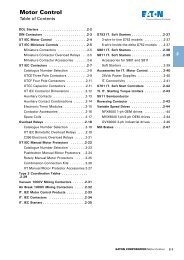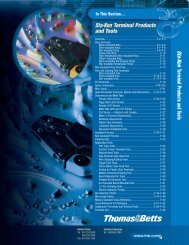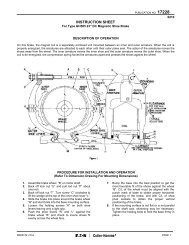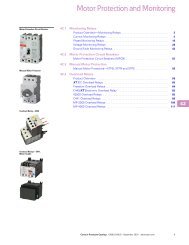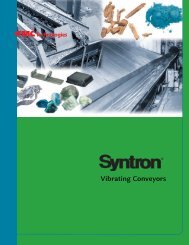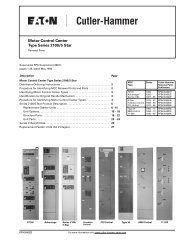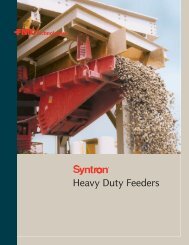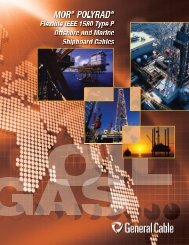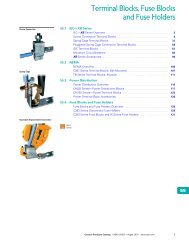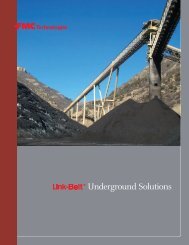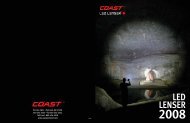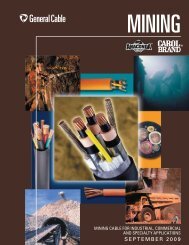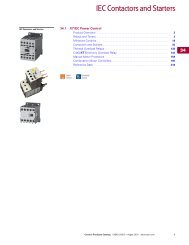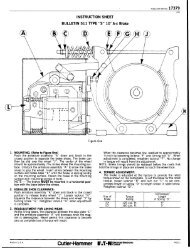Syntron® Vibrators - FMC Technologies
Syntron® Vibrators - FMC Technologies
Syntron® Vibrators - FMC Technologies
Create successful ePaper yourself
Turn your PDF publications into a flip-book with our unique Google optimized e-Paper software.
Pneumatic <strong>Vibrators</strong><br />
PV and PVS Piston Vibrator Series<br />
Positive Punch for Difficult Applications<br />
Syntron ® Piston <strong>Vibrators</strong> from <strong>FMC</strong><br />
<strong>Technologies</strong> assure the flow of materials<br />
through bins, chutes and weigh batchers.<br />
Their cast iron, flat base construction provides<br />
an efficient means of transmitting shock energy<br />
developed by the reciprocating piston<br />
to the mounting surface.<br />
Syntron Piston <strong>Vibrators</strong> are available in two<br />
models: High impact (PV) and Reduced Noise<br />
(PVS). PVS vibrators (impact against a cushion<br />
of air) can be used where noise is objectionable.<br />
Unlike turbine vibrators, piston vibrators<br />
require lubrication with oil, SAE-10 or lighter.<br />
Lack of oil in the air rapidly wears down the<br />
piston and cylinder wall.<br />
Syntron ® PV and PVS Pneumatic Piston Vibrator models.<br />
Features and Benefits<br />
■ Cast iron, flat base construction.<br />
■ One-piece housing<br />
■ Flange mounted<br />
■ Ideal for use in mining, chemical, concrete,<br />
plastics, steel, foundry and paper industries<br />
■ Available in high impact (PV) or reduced noise<br />
(PVS) models<br />
■ High thrust reciprocating action of PVS models<br />
permits operation at low air pressures<br />
■ High impact, linear force and efficient energy<br />
transfer assures flow of materials through bins,<br />
chutes and weigh batchers<br />
■ Linear vibration<br />
■ Impacts in both directions<br />
Piston Vibrator Selection<br />
In order to move material in a bin or hopper, the friction<br />
between the material and the bin wall must be broken. Once<br />
the friction is broken, material cannot cling to the sides of<br />
the bin and it will flow out through the discharge. A prime<br />
consideration in selecting the correct piston bin vibrator is<br />
wall thickness. The following formulas calculate material in<br />
the restricted area which is used as a guide to determine the<br />
number of piston bin vibrators necessary.<br />
■ Calculate the weight of the material in the transition or<br />
sloping part of the bin. Normally, this is the only place where<br />
the friction between the material and the bin side has to be<br />
broken. Do not calculate the total weight, only what is in the<br />
transition part of the bin.<br />
■ For conical bins, calculate as follows:<br />
0.261 x dia. 2 x height x material density in lb/ft 3 (kg/m 3 )<br />
■ For rectangular bins, calculate as follows:<br />
Length x width x height x 1/3 x material density.<br />
Chutes<br />
The force required of the vibrator is equal to the weight<br />
of the chute plus vibrator plus maximum material in the<br />
chute. See page 43 for more detail.<br />
42



